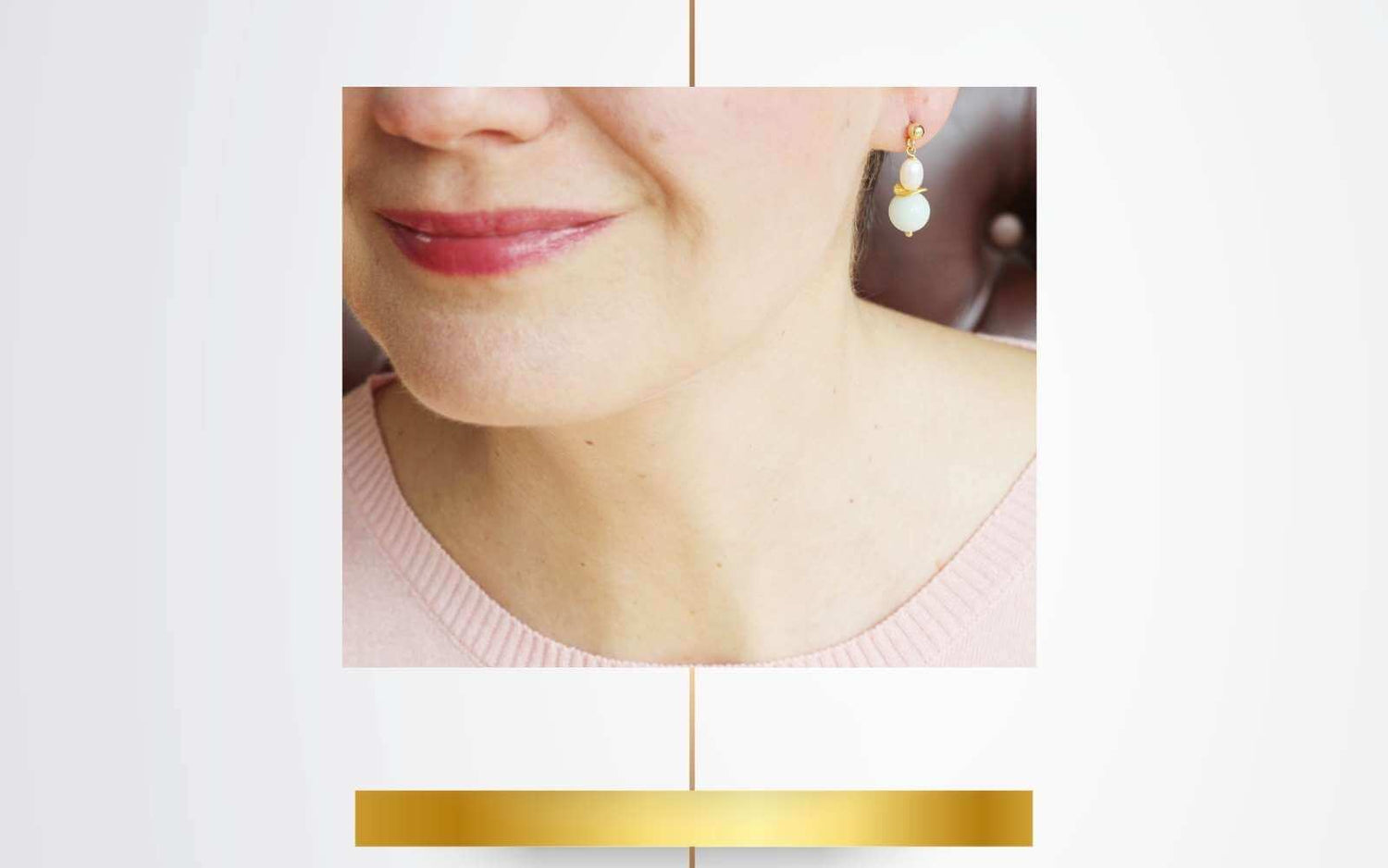
Pearl Earrings are Always Appropriate
Pearl Earrings
Earrings are one of the most popular pieces of jewellery and no outfit is complete without a pair of beautiful pearl earrings. Pearl earrings have been a classic jewellery piece for decades. Nowadays, they are available in many different styles making it almost impossible not to find a pair that suits your lifestyle and fashion preferences. In this blog post, we explain different types of pearls, where they come from, how to value them, and how to style this beautiful gem of nature so you can appreciate them fully.
Meaning of Pearls
Pearls represent wisdom gained through experience. They will help you learn the lessons from every life experience and will make you wiser and stronger for it. Pearls are said to promote faith, loyalty and truth. They have long been associated with purity, humility and innocence. Wearing pearls gives the wearer a sense of confidence and assurance. Pearls are soothing and carry maternal, nurturing and supportive vibrations. Pearl earrings have been traditionally given as a wedding gift. Also, pearls remain the gemstone known as the June birthstone.
Hardness of Pearls
Pearls are the only gemstones in the world that come from living creatures. Pearls are ranked 2.5 on the Mohs hardness scale, which means they are very soft and easily scratched. At the same time, they are tough due to their internal microcrystalline structure which makes them almost impossible to break into pieces. There are two main categories of pearls: freshwater and saltwater. Each type then can be natural and cultured. Unlike gemstones that are measured by carat, a pearl’s weight is given in grains.
Where do Pearls for Pearl Earrings Come From?
Most gemstones are found on the Earth while pearls have an organic origin. They are created when a very small fragment of rock, a sand grain or a parasite enters the mollusc’s shell. It irritates the oyster or clam, which reacts by coating the foreign material with layer upon layer of shell material called nacre. The nacre is also a substance that gives pearls their lustre. Some pearls take six months to form while bigger pearls can take up to four to five years to grow. In saltwater settings, pearls are found in oysters, while in freshwater they are produced by mussels. Almost all pearls today are cultured on pearl farms.
Japan and China both produce Akoya cultured pearls. Australia, Indonesia, and the Philippines are leading sources of the South Sea saltwater cultured pearls. Tahitian pearls are cultivated primarily around the islands of French Polynesia of which the most familiar is Tahiti. China is the leading source of freshwater cultured pearls.
Cultured Pearls Types
There are four main types of cultured pearls used in pearl earrings and other pearl jewellery. Each of them is special in its own way and valued for its distinctive characteristics.
Akoya cultured pearls - are saltwater cultured pearls from the Akoya oyster. White and cream-coloured pearls are mostly used in single-strand necklaces as they are known for being perfectly round.
South Sea cultured pearls - are the most valued of all pearl types as it takes a long time for them to grow. They are usually bigger and come in white or silver to golden colours.
Tahitian cultured pearls - are all about pearl overtones. The pearls’ body colour might be grey, black or brown, with blue, green, purple or pink overtones.
Freshwater cultured pearls - are the most commonly produced pearls with wide commercial availability. They have a wide range of sizes, shapes and colours.
Freshwater Pearls in Our Pearl Earrings
Pearl earrings in our jewellery range feature freshwater cultured pearls. We like to mix pearls with gemstones and add them as a special feature in our gemstone earrings rather than making pieces only with pearls. Oval pearls that we use add a touch of elegance and style to our gemstone earring designs.
An abundant selection of shapes, sizes and colours makes freshwater pearls an affordable and innovative option for creating new looks, designs and combinations. Recently they have increased in popularity offering the most unique and interesting designs.
Shapes in cultured freshwater pearls can vary due to their cultivation process. They are generally smaller with less lustre than saltwater pearls as they take a shorter time to form. Over 90% of freshwater pearls are irregular in shape. We use oval freshwater pearls for our pearl earrings and irregular shapes such as; oval, baroque, stick and coin for our necklaces with pearls. Oval pearls are shaped like ovals and are categorised as symmetrical shapes. They are narrower at the ends than in the centre. As for their colour, white and cream shades with overtones of pink and cream are the most typical.
How to Wear Pearl Earrings
Your face is the first feature someone sees which makes the earrings the most important accessory you can wear. Earrings help you accentuate your face shape, skin tone and hairstyle. They can enhance your best features as well as add vibrancy and personality to your outfit. Pearl earrings are beautiful and classic yet fashionable pieces of jewellery that can be worn by any woman regardless of fashion style or age. They are very versatile as they can be paired with casual as well as formal wear. Pearls are meant to give your skin a luminous glow.
When choosing your pearl earrings think about what suits your overall style and what goes well with your hair and skin tone. You can play with your hair when wearing pearl earrings and style it in a bun for an elegant look or leave it down for a more easygoing appearance.
Pearls have been a major jewellery trend for several seasons now. This season will see a few new ways to style this classic gemstone. Combining colourful gemstones with pearls is very popular this spring and summer. Mismatched earrings are fashionable threader earrings as well as baroque pearl earrings if you are after a more statement or edgy look.
How Can You Identify Real Pearl Earrings?
Pearl earrings have been made with fake pearls for a long time to imitate pearls’ lustre. Materials like glass, plastic and shells have been used. To test whether your pearls are real or fake, there are three methods you can use:
The “Tooth Test” - rub a pearl across the surface of your teeth. A real pearl will feel slightly gritty or rough. Most imitations will feel smooth as the coating over plastic or glass feels very even.
Rub two pearls together – they should feel grainy and not smooth. Real pearls have texture to them.
“Scrape” the pearls with scissors – of course, do it only gently. This shouldn’t damage the lustre as it extends through all the layers of nacre in genuine pearls.
How to Buy Cultured Pearls
When buying pearl earrings or any other pearl jewellery you should consider and pay attention to the following qualities of the pearls specified by GIA: size, shape, colour, lustre, surface quality, nacre quality and matching for jewellery with two or more pearls.
Size - larger pearls are rarer and thus more valuable than smaller pearls
Shape-round is the most difficult and rarest shape in culture and for that reason is the most valuable
Colour - pearls occur in a wide range of hues. There are warm hues like yellow, orange and pink, and cool hues like blue, green and purple.
Lustre – is the most important quality of the pearl which gives it beauty and will determine its value. Lustre is graded as excellent, very good, good, fair and poor.
Surface quality – if surface features are numerous or severe they can impact the value of pearls. They are shown by abrasions that look like a series of scratches, a flattened section or an irregular ridge that looks like a crease or wrinkle.
Nacre quality – nacre is the material pearls are composed of. Lustre and nacre quality are closely related. If the nucleus is visible under the nacre, or if the pearl has a dull appearance, you can assume that the nacre is thin which affects the quality of lustre.
Matching – pearls should match all the quality factors mentioned above
Caring For Your Pearl Earrings
Follow these guidelines on how to care for your pearl earrings and other pearl jewellery to be able to enjoy them for a long time and maintain their elegant lustre. Pearls are delicate and require extra special care. They can be damaged by contact with many chemicals found in household cleaners, perfumes, cosmetics and hair care products.
Store your pearl earrings in a jewellery box separate from other gemstones
Put on your pearls last when dressing up and take them off first after you come home
After wear wipe them with a cloth
Use a damp cloth to occasionally clean your pearls, never submerge them in water
Make sure you wear your pearls regularly as your body’s natural oils will keep them lustrous and glowing.
Conclusion
Pearls possess a uniquely delicate translucence and lustre that place them among the most highly valued gemstones. Pearl earrings are classic and timeless and to this day continue to be viewed as a mark of taste and refinement as well as a symbol of purity. Pearls will never go out of style regardless of current fashion trends. For that reason, you can never go wrong by adding a lovely pair of pearl earrings to your jewellery collection.
References:






